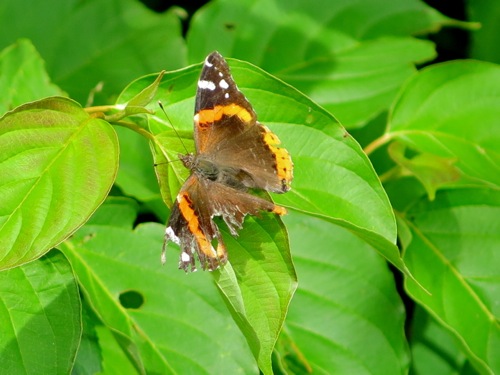The old time Universalists were fond of saying that “God is love.” That statement may be true, but not in any sentimental sappy sense. Many years ago, Tennyson pointed out that he who might place trust in the belief that “God was love indeed / And love Creation’s final law” needed to remember that “Nature, red in tooth and claw … shriek’d against his creed.”
On our walk today, Abs and I saw a butterfly that had lost much of its left hindwing, and a part of its left forewing. We speculated that perhaps a bird or other predator had attacked the butterfly, and somehow it had gotten away, and was still flying:

Living things need to eat, and as often as not they eat other living things in order to stay alive. And this is true of you, too, O human being who think yourself an apex predator: there are plenty of microorganisms and parasites and biting insects who feed on you.

You spoiled this potential butterfly inspiration graphic about perseverance. The “you are food” message wasn’t what I was expecting.
Carol, don’t you find it inspirational knowing that some persevering organism will live because it preys on you? No? You don’t? Oh.
It would be more romantic to be preyed on by a tiger, but I guess a virus will probably get me instead. How humiliating: to be brought down by a predator whose status as a living organism isn’t even quite established.
Amy, Carol just found a book in the local thrift shop titled The Man-Eaters of Kumaon, and for those who would like to be preyed upon by a tiger, the author, Major Jim Corbett, states the following:
“When a tiger is suffering from one or more painful wounds, or when its teeth are missing or defective and its claws worn down, and it is unable to catch the animals it has been accustomed to eating, it is driven by necessity to killing human beings. The changeover from animal to human flesh is, I believe, in most cases accidental. As an illustration of what I mean by ‘accidental’ I quote the case of the Mukestar man-eating tigress. This tigress, a comparatively young animal, is an encounter with a porcupine lost an eye and got some fifty quills, varying in length from one to nine inches, embedded in the arm and under the pad of her right foreleg. Several of these quills after striking a bone had doubled back in the form of a U, the point and the broken-off end being quite close together. Suppurating sores formed where she endeavored to extract the quills with her teeth, and while she was lying up in a thick patch of grass, starving and licking her wounds, a woman selected this particular patch of grass to cut as fodder for her cattle. At first the tigress took no notice, but when the woman had cut the grass right up to where she was lying the tigress struck once, the blow crushing in the woman’s skull. Death was instantaneous, for, when found the following day, she [the woman] was grasping her sickle with one hand and holding a tuft of grass with the other….”
For the woman, the first of twenty-four humans which this tigress killed, death would have been quicker and less painful than, say, dying of Ebola, or dying of mad cow disease which is caused by prions that are even less alive (if I may state it that way) than viruses. Not only would it be far more romantic to be preyed upon by a tiger, it would be far less unpleasant — although from the tiger’s point of view, it doesn’t sound pleasant at all.